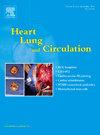Fractional Flow Reserve Versus Angiography-Guided Revascularisation in Patients With Severe Aortic Stenosis: A Systematic Review
IF 2.2
4区 医学
Q2 CARDIAC & CARDIOVASCULAR SYSTEMS
引用次数: 0
Abstract
Background
Aortic stenosis (AS) and coronary artery disease usually coexist in older adults. Although fractional flow reserve (FFR) is the gold standard for demonstrating functionally significant coronary artery stenoses, its efficacy in patients with severe AS awaiting transcatheter aortic valve implantation is unclear. This systematic review assesses the clinical outcomes between FFR- and angiography-guided coronary revascularisation in patients with severe AS.
Method
This review conformed to the Preferred Reporting Items for Systematic Reviews and Meta-Analyses (PRISMA) guidelines. PubMed, Ovid MEDLINE, Web of Science, and Cochrane databases were searched until 12 March 2024. Eligible studies included randomised controlled trials or observational studies including patients with severe AS with concurrent coronary disease comparing FFR- with angiography-guided percutaneous coronary intervention. Primary outcomes were all-cause mortality and myocardial infarction. Secondary outcomes were composite major adverse cardiovascular events.
Results
Five retrospective cohort studies were identified, including 1,927 patients. The average follow-up was 34.7 months. FFR-guided cohorts exhibited higher incidence rates for all-cause mortality (17.4% vs 15.6%), myocardial infarction (4.4% vs 3.3%), and major adverse cardiovascular events (21.8% vs 18.5%) than the angiography-guided cohorts. A total of 32.8% the angiography-guided cohort and 33.1% from the FFR-guided cohort underwent percutaneous coronary intervention. Due to insufficient power and inconsistency of the available data (including heterogenous patient selection criteria, differences in procedural protocols, anatomical distribution of stented lesions, non-uniform reporting of measured outcomes), a meta-analysis for the primary and secondary outcomes was not conducted. The methodological quality of the included studies was found to be of fair quality according to the Newcastle–Ottawa checklist.
Conclusions
Despite the recognised usefulness of FFR in the assessment of coronary artery disease, its clinical efficacy in patients with severe AS undergoing transcatheter aortic valve implantation remains uncertain amidst inconclusive observational data. Large-scale randomised controlled trials are required.
严重主动脉狭窄患者的分流储备与血管造影引导下的血运重建:一项系统综述。
背景:主动脉瓣狭窄(AS)和冠状动脉疾病通常在老年人中共存。虽然分数血流储备(FFR)是证明功能性显著冠状动脉狭窄的金标准,但其在等待经导管主动脉瓣置入术的严重AS患者中的疗效尚不清楚。本系统综述评估了FFR和血管造影引导下的冠状动脉血管重建术在严重AS患者中的临床效果。方法:本综述符合系统评价和荟萃分析的首选报告项目(PRISMA)指南。PubMed、Ovid MEDLINE、Web of Science和Cochrane数据库被检索到2024年3月12日。符合条件的研究包括随机对照试验或观察性研究,包括合并冠心病的严重AS患者,比较FFR与血管造影引导下的经皮冠状动脉介入治疗。主要结局为全因死亡率和心肌梗死。次要结局为复合主要不良心血管事件。结果:纳入了5项回顾性队列研究,包括1927例患者。平均随访34.7个月。ffr引导的队列在全因死亡率(17.4% vs 15.6%)、心肌梗死(4.4% vs 3.3%)和主要不良心血管事件(21.8% vs 18.5%)方面的发生率高于血管造影引导的队列。在血管造影引导的队列中,32.8%的患者接受了经皮冠状动脉介入治疗,在ffr引导的队列中,33.1%的患者接受了经皮冠状动脉介入治疗。由于权力不足和现有数据的不一致(包括异质患者选择标准,手术方案的差异,支架病变的解剖分布,测量结果的不统一报告),没有对主要和次要结果进行荟萃分析。根据纽卡斯尔-渥太华检查表,纳入研究的方法学质量是公平的。结论:尽管FFR在评估冠状动脉疾病方面的有效性得到公认,但由于观察数据不确定,其在重度AS经导管主动脉瓣植入术患者中的临床疗效仍不确定。需要进行大规模随机对照试验。
本文章由计算机程序翻译,如有差异,请以英文原文为准。
求助全文
约1分钟内获得全文
求助全文
来源期刊

Heart, Lung and Circulation
CARDIAC & CARDIOVASCULAR SYSTEMS-
CiteScore
4.50
自引率
3.80%
发文量
912
审稿时长
11.9 weeks
期刊介绍:
Heart, Lung and Circulation publishes articles integrating clinical and research activities in the fields of basic cardiovascular science, clinical cardiology and cardiac surgery, with a focus on emerging issues in cardiovascular disease. The journal promotes multidisciplinary dialogue between cardiologists, cardiothoracic surgeons, cardio-pulmonary physicians and cardiovascular scientists.
 求助内容:
求助内容: 应助结果提醒方式:
应助结果提醒方式:


